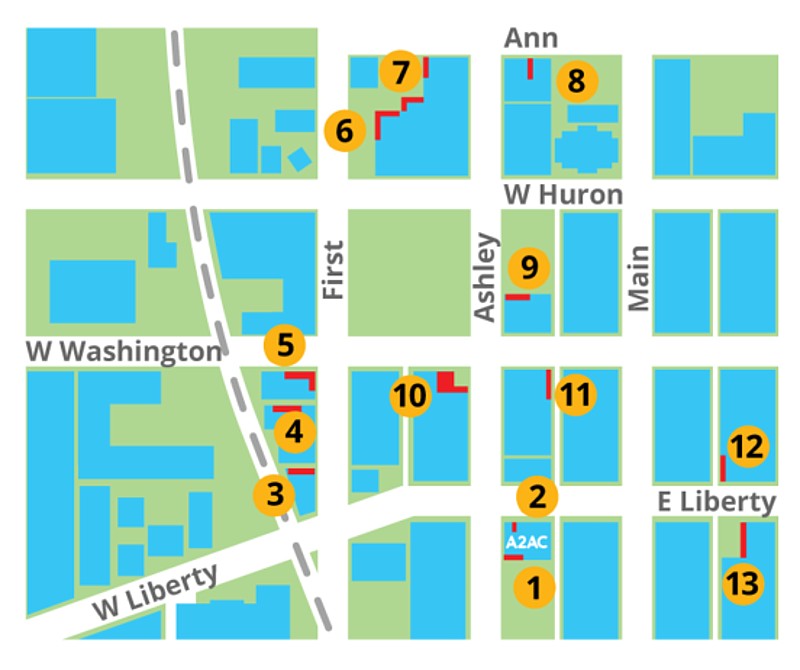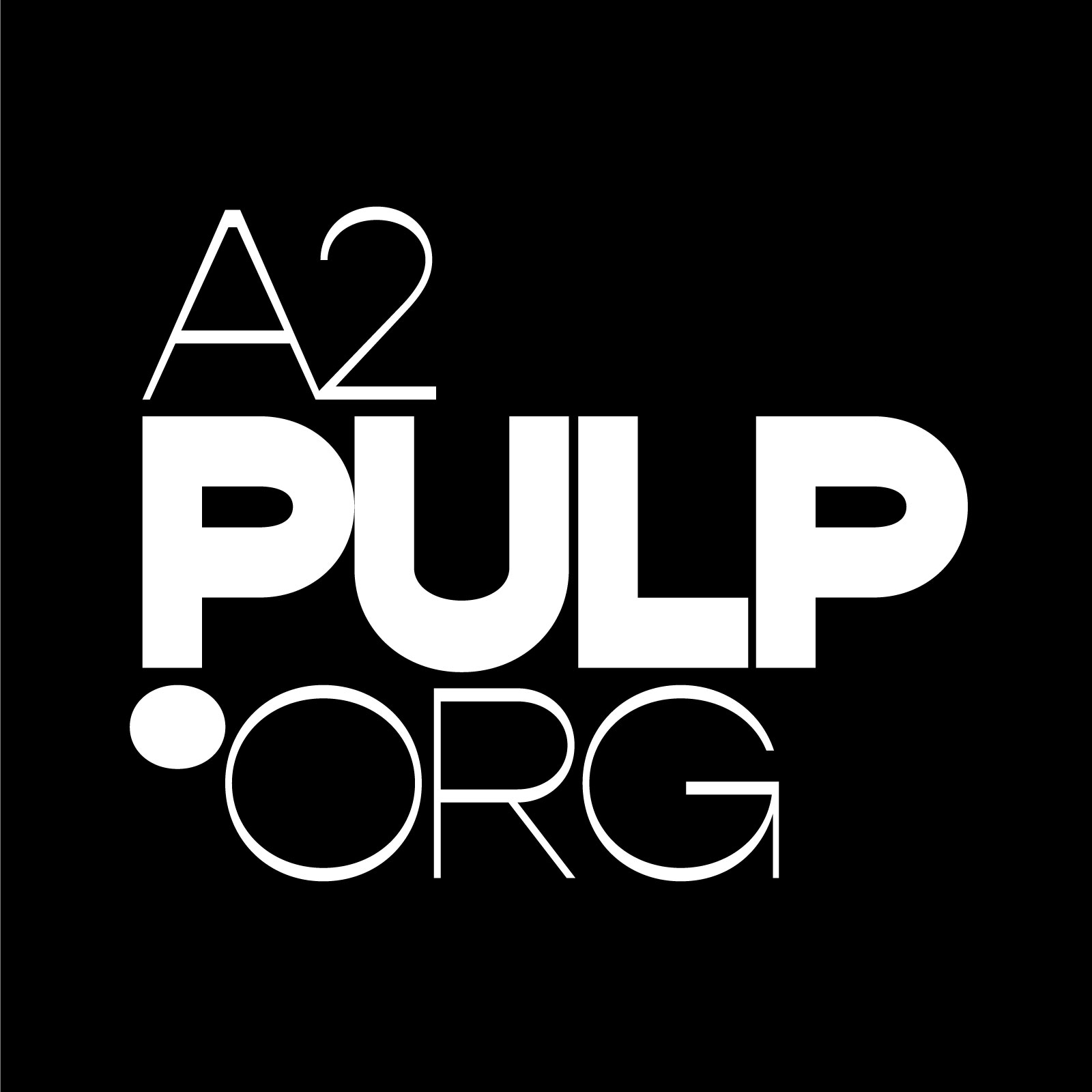A guide to the Ann Arbor Art Center's Art in Public Places murals project

Ann Arbor has innumerable large- and small-scale murals already, but they have new company as the result of a crowdfunded project to bring art to walls and alleys around town.
In July, the Ann Arbor Art Center (A2AC) raised more than $50,000 to commission 10 murals around the city. The fundraiser was through Patronicity, and once the goal was met, the Michigan Economic Development Corporation (MEDC) matched the donations to double the money available to the mural artists. At the onset of the project, 10 artists paired with local business owners on the sites of their future murals. In October, two additional murals were announced, raising the total to 12. This initiative is part of the ongoing A2AC Art in Public program that aims to make art “accessible and equitable to everyone,” relying on community-based donations.
Since the Art Center helped crowdfund two other public murals in the recent past, those have been added to the A2AC Murals Map, which features a walking tour of all the works. Currently, 13 murals are finished, with the 14th debuting sometime in 2021.
Here's a rundown of all A2AC's mural commissions, starting with the two that were preludes to the larger project.
Pat Perry is a muralist and multimedia artist who has done works across Michigan, America, and internationally. Perry’s mural is at 117 S. Ashley St., near the Cupcake Station on E. Liberty St. The mural was installed in 2018 as one of A2AC’s earlier publicly funded projects. The large-scale mural depicts a man sitting in front of a grassy field, holding a toy sailboat in his hand.
Jesse Kassel, a Detroit-based artist, installed a pretzel-themed mural at 120 E Liberty St., aka the iconic Pretzel Bell building, in August 2019.
In 2020, 12 more murals were slated for installation around downtown Ann Arbor, though one has been postponed until sometime in 2021, bringing the current total of A2AC murals to 13.
Ypsilanti-based artist Gary Horton’s mural Not Afraid to Dance—with a palette of bright red, with contrasting blue and green accents—is located on The Circ Bar's alley wall at 210 S First St. Horton grew up in Ann Arbor, attending Huron High School, then moved to Pennsylvania in 1996 to study at the Art Institute of Pittsburgh. Since then, his public murals and paintings are familiar acquaintances around Ann Arbor and Ypsilanti, even before the Circ Bar work, which contains abstract, linear elements such as a bullseye, lines, and spheres. Horton's signature robots can be seen around Ann Arbor and Ypsilanti at businesses such as Tree Town Treasures, Go! Ice Cream, Brick & Mortar, and Unicorn Feed & Supply—just to name a few. Horton installed a mural inside Ytown Recreation in February 2020 and another at Rising Star Academy in Center Line in June. Ann Arbor Art Center describes Horton’s visual style as being influenced by graffiti: “[B]eing classically trained in oil painting, Gary would spend late nights in train yards and rooftops learning the forbidden art of graffiti. Today you can see the influence of these two styles in the community.“

Dokebi, or Chris Sammons, is a multimedia artist and graphic designer specializing in “branding, illustration and character creation,” including many advertisements for companies such as YouTube and Google. This year, he collaborated with Strangecat Toys to create a Dokebi vinyl toy. In early September, Dokebi installed his first commissioned mural in the alley at the Blind Pig, 208 S. 1st St. Sammons’ character Dokebi is inspired by the dokkaebi, a creature from Korean mythology and folklore. The creatures are colloquially known as “Korean goblins,” mythical beings that are known to be tricksters and possess inanimate objects. Dokkaebi are usually depicted wearing the traditional Korean two-piece dress known as the hanbok or Chosŏn-ot. The Ann Arbor Art Center states that “Chris’s work embodies that playful yet delinquent spirit in his modern interpretation of the dokkaebi.” In the mural outside of the Blind Pig, the dokkaebi’s influence is clear, if you know what to look for. The mischievous goblins fit in well among the heavily graffitied walls of the Blind Pig alley.
W. C. Bevan, a musician, photographer, and multimedia artist who lives and works in Detroit, has influences that include music, architecture, and movement. His mural is located in the Ann/Ashley parking structure at 220 N. Ashley St., at the cross streets Huron and Main, painted underneath the structure in monochromatic tones, with both bold and detailed lines and shapes. Bevan is also influenced by graffiti, a component seen throughout the mural. The Art Center summarizes his practice by saying his mural and painting work is "focused on high contrast visual movement, imaginary extensions of architecture, uncommon rhythms rooted in free-associative practices, self-reflective scenarios rooted in an embrace of chance/change, and a deep respect for folk art traditions and their regional manifestations.” Bevan’s mural is a dynamic visual experience, with juxtaposing shapes contained by an odd symmetry. It also contains a “Shape Guide” to aid—or possibly confuse—viewers further in their engagement with the work.
Ann Lewis is a Detroit-based interdisciplinary artist and activist. She is one of two additional artists brought on in October to install a mural, May Her Memory Be Our Innermost Revolution, behind the building at 123 N. Ashley St., near the corner of Ann and First streets, and extends over the expansive rear walls. The multi-panel work is comprised of vibrant backdrops in a cool-toned ombre, with large-scale, bright labyrinth overlays. Lewis’ complex practice is summarized in her “About” section on both her website and the Art Center’s mural page. This text notes that her works are public, participatory, and performative, and work to engage with and respond to current social and political realities: “As an interdisciplinary activist artist, she incorporates painting, installation, sculpture, and participatory means to explore themes related to American identity, power structures, and justice. Ann’s work often includes repetition through graphic elements, and a limited color palette while conveying messages around intersectional social justice issues such as gentrification, women’s rights, and police brutality.” The labyrinthine design repeated on three different walls is a common element in Lewis’ past works; in this instance, the cheery, Day-Glo hues of the linework contrast against the calm blues of the background, creating an intense visual contrast.
Live in Color is a University of Michigan student organization with more than 350 members and its mural is located on the wall behind the Ann Arbor Art Center at 117 W. Liberty St. The group uses color psychology to turn “bleak and blank spaces” into bright, vibrant ones. Live in Color's interdisciplinary approach aims to “improve community morale through art and design while creating an interdisciplinary space where a diverse group of people can express themselves creatively and build a community.” The organization's murals can be found around Ann Arbor, at places like RoosRoast Coffee, Bløm Meadworks, and various University of Michigan buildings on campus. Live in Color's installation at the Ann Arbor Art Center replaced a prior representational mural in favor of an abstract work with an emphasis on shape, color, and architectural nods.

Midnight Olive, aka Olivia Guterson, is an interdisciplinary artist based in Detroit who is “deeply influenced by her Jewish and Black heritage.” Guterson utilizes black ink against white backdrops to “[accentuate] the balance of black and white, busy and still, negative and positive, and the valid in-betweens” with her linework, guided by “meticulous, instinctive wisdom.” Guterson’s mural is located at 111 N. Ashley St. and features her signature linework in black against a white background. The meditative piece wraps around the lower portion of two walls, creating a dado effect.
Ouizi (Louise Jones) is a muralist well-known for her large floral works. Ouizi lives and works in Detroit, and was born and raised in Santa Monica, Calif. Her works can be seen across the United States and internationally, usually with the incorporation of “site-specific plants and animals.” Drifts, her Ann Arbor mural at 200 S. Ashley St. on the corner of Ashley and Washington, includes two Michigan native species, Echinacea and Rudbeckia. Her signature style is “informed by her education in drawing and printmaking. Her affinity for botanical subjects continues to grow, stemming from an early introduction to Georgia O’Keeffe and fond memories of picking figs with her grandmother.” On her Instagram, Ouizi writes that Drifts was inspired by her trip to both Nichols Arboretum and Matthaei Botanical Gardens last summer, and the title “refers to the method in garden design of imitating the natural growth habits of plants by planting single varieties in large swaths, making it appear as though they have propagated naturally.” The lush, colorful mural can be viewed from multiple angles and is meant to be an immersive experience. Ouizi’s mural recreates the magical space of an outdoor garden in summer. Though I saw the mural in early fall, I imagine it is even more rewarding amidst the bleakness of winter.
Nina Shahin is a Southeast Michigan-based visual artist and painter who is “focused on the use of color, space, and shape to create memoryscapes that challenge the traditional narrative of storytelling and remembering. Shahin’s absract mural, located in Spencer’s alley wall at 113 E. Liberty S., has an earthy pastel palette with both natural and architectural references.
John Sauve is a sculptor and his unconventional "mural" is located at 117 W. Liberty St., atop the Ann Arbor Art Center. The sculpture is part of The Man in the City International Sculpture Project, which has installed more than 100 sculptures in Michigan, Canada, and New York. The aim is to create “a metaphor for life that transforms skylines and encourages people to look around. In the discovery process, one becomes aware of their own sense of place within the city.” Sauve’s work is a bright orange figure that can be seen on the skyline, if you know where to look. This project is also a means to “highlight historical buildings (the Walker Carriage Works Building dates back to 1870 and is a part of the Liberty Street Historic District).” Sauve’s sculptural contribution is unlike any other work in this project, stretching the definition of what a mural can be and subtly altering the landscape of the Ann Arbor Art Center’s building.

Taylor White is an American artist based in Raleigh, North Carolina. She works primarily with paint and large-scale murals, with a focus on bright, figural works. White’s mural is located on the North and East facades of the Clinc Inc. building, 200 S. First St., near the corner of Washington and First. White’s work is described as a combination of “refined techniques of classical training with bright, unexpected color choices born from the residue of street art and pop culture.” Her work is also influenced by technology, which she summarizes in a statement she wrote on the piece:
The mural considers the relationship between humanity and technology as we move into a future where these elements are inherently interwoven. The hands delicately and hopefully explore the relationship with the digital space, while points of tension are created visually as the horizontal shapes cut through the composition.
While the tools that have developed over the last ten years have created unprecedented breakthroughs in our ability to connect, socialize and share information across continents, some believe that social media and the tech leviathans who created it pose an existential threat to civilization. There are evidence-based arguments that social media platforms dehumanize their users, disrupt the social fabric, and collapse our shared understanding of reality. Documentaries like ‘The Social Dilemma’ reveal that the technology utilized by social media is manipulative by design, using our own psychology against us in service of its own interests.
So, what do we do with what we know? Technology is here to stay, but that doesn’t mean we are helpless to its advances. We have a choice to hold ourselves and the tech companies accountable for how we use the tools at our disposal.
These influences are clear in A2AC mural, which consists of a dark backdrop with pixelated swaths of brightly colored forms that disrupt and flow through the figurative elements of the work.
Avery Williamson is an Ann Arbor-based multidisciplinary artist working with a variety of media, including weaving, photography, drawing, painting, and collage. Her mural, What the Water Gave Me, is on the alley wall at 113 W. Washington St. near the corner of Ashley, around the corner from the former home of Vogel's. In late October, the Ann Arbor Art Center posted a summary of Williamson’s installation on its Facebook page:
The result is an abstract explosion of color, line, and shape that, like the other murals that have come to completion this fall, feels completely of its own. Avery is no stranger to the A2AC, with her work being one of the many that made up our final exhibition before lockdown, The Space Between, curated by one of her murals cohorts, Olivia Guterson (aka Midnight Olive). The artist also just completed her 6-month residency at The Hosting artist program located in Ypsilanti, MI.
Williamson's mural is installed on panels, each of the three panels being made up of four smaller segments. Williamson executed the work on panels in order to preserve the historic wall that her mural now hangs on. The white backdrop is painted with one of her signature styles: brushstroke linework. Shades of blue are applied with varying widths, moving deftly throughout the composition. As the title suggests, the experience of viewing the work is reminiscent of experiencing water flowing peacefully, though lively and immersive.
New York native, U-M grad, and Leon Speakers founder Noah Kaplan’s mural will be installed at 315 W. Huron St., across from the Delonis Center, sometime in 2021.
But right now, the 13 public, outdoor murals that have been brought to life over the past two years by Ann Arbor Art Center are available for viewing anytime.
Elizabeth Smith is an AADL staff member and is interested in art history and visual culture.


































